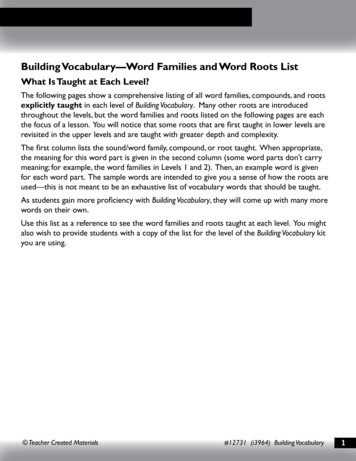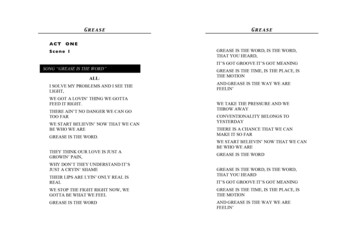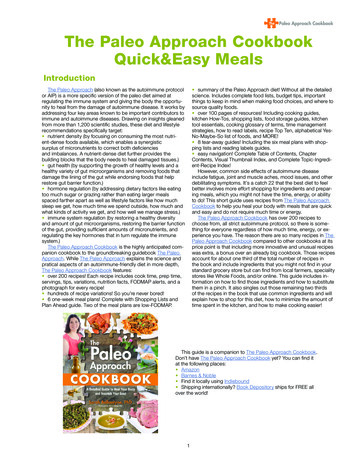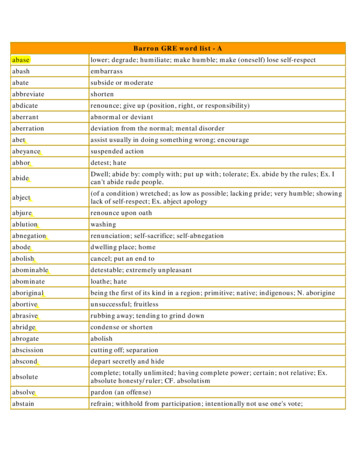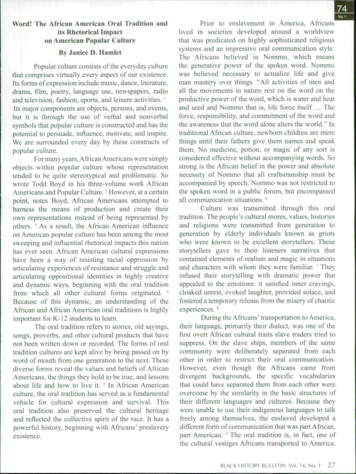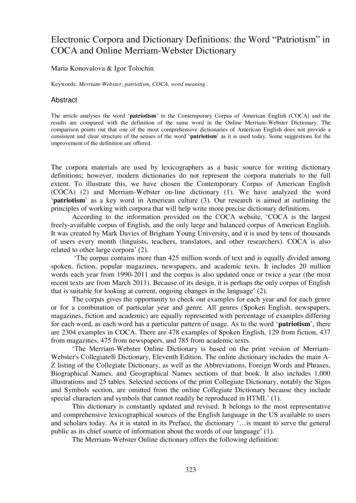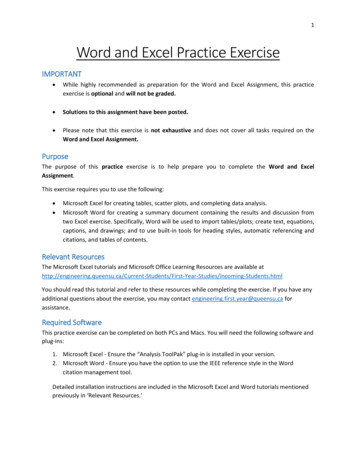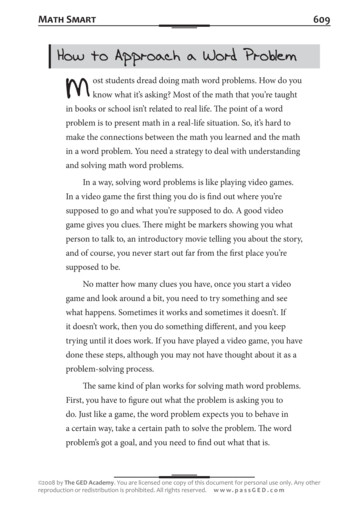
Transcription
Math Smart609How to Approach a Word ProblemMost students dread doing math word problems. How do youknow what it’s asking? Most of the math that you’re taughtin books or school isn’t related to real life. The point of a wordproblem is to present math in a real-life situation. So, it’s hard tomake the connections between the math you learned and the mathin a word problem. You need a strategy to deal with understandingand solving math word problems.In a way, solving word problems is like playing video games.In a video game the first thing you do is find out where you’resupposed to go and what you’re supposed to do. A good videogame gives you clues. There might be markers showing you whatperson to talk to, an introductory movie telling you about the story,and of course, you never start out far from the first place you’resupposed to be.No matter how many clues you have, once you start a videogame and look around a bit, you need to try something and seewhat happens. Sometimes it works and sometimes it doesn’t. Ifit doesn’t work, then you do something different, and you keeptrying until it does work. If you have played a video game, you havedone these steps, although you may not have thought about it as aproblem-solving process.The same kind of plan works for solving math word problems.First, you have to figure out what the problem is asking you todo. Just like a game, the word problem expects you to behave ina certain way, take a certain path to solve the problem. The wordproblem’s got a goal, and you need to find out what that is. 2008 by The GED Academy. You are licensed one copy of this document for personal use only. Any otherreproduction or redistribution is prohibited. All rights reserved. w w w . p a s s G E D . c o m
610Math SmartNext, you have to look for clues, just like you would in a videogame. Is there a path that looks like you’re supposed to follow it?Are there hints that seem to point in a direction? While you’repracticing for the GED, you can circle the clues or underline thewords in the problems you’re working on, so you will rememberto use them later. On the GED math test, you’ll have notepaper towrite down important information.On the next step, it's easy to get off track, and sometimes youcan waste a lot of time. This step is the solving part. If you rushinto it without a plan, you can do the wrong operation or not dothe operations in the right order, like dividing when you should bemultiplying. Think through what the problem is asking and whatinformation you have to make a plan to solve the problem, andthen work it through.The last step in solving word problems is different from avideo game, because you don’t really have to check your work in agame. In a game if it doesn’t work, you just try something different.In a math problem, they don’t tell you if you did it right (at leastnot right away). You do not get points, or get shot at, or lose therace. In a math word problem, take a look at it when you are doneto see if it makes sense. Try to solve it in a different way and seeif the answer comes out the same. If it doesn’t, then somethingis definitely wrong. On multiple choice questions, you’ve got animmediate way to check your answers: compare them with themultiple choice answers. On free-form grid answers, make sureyour solution will fit into the grid.For math word problems here are the four steps to use:1.First, figure out what the question is asking for. 2008 by The GED Academy. You are licensed one copy of this document for personal use only. Any otherreproduction or redistribution is prohibited. All rights reserved. w w w . p a s s G E D . c o m
Math Smart2.611Second, look at the clues, the information the problemgives you.3.Third, put together a plan and then solve it.4.And fourth, check your work to see if it makes sense.Let’s try working through a typical math word problem, usingthis strategy.You may use a calculator for this question.Gregor manages a machining shop which makes specializedbolts. One worker can generate 112 bolts per hour andworks 8 hours per day. Gregor’s biggest customer needshim to fill an order for 15,000 bolts in the next 5-day workweek. How many workers does Gregor have to schedule tofill the order?Enter your answer on the answer grid:S ee " T he G EDFr ee - E nt ryG ri d s " t ol e a r n ab o utans w e r g ri d s ! 2008 by The GED Academy. You are licensed one copy of this document for personal use only. Any otherreproduction or redistribution is prohibited. All rights reserved. w w w . p a s s G E D . c o m
612Math SmartSo, how do you go about solving this problem? Let’s take it onestep at a time:1. Fi rst , fig ur e o ut w hat t heque stio n is a skin g f o r . Read throughthe question and make sure you understand it. There’s a lotof information there. But it boils down to one question: Howmany workers will it take to make 15,000 bolts in five 8-hourdays? Sometimes it helps to rewrite the question in your ownwords to make sure you understand what it’s asking.2. Sec o n d , l o ok at t h e c l u e s , t h ei nfo r m atio n t h e p r ob l e m gi v e sy ou. The problem gives you a lot of information. It canhelp to make a chart of the information in the problem, or justnote it down, so it’s clear and easy to read:orkers?wynaHow mbolts000,erGoal: 15bolts p211 r1 workehourrurs peoh8,5 daysday3. Thir d , p ut t o g et h e r a p l an an dt hen so l v e it . How do you get from theinformation to the solution? You’ll need to use reasoning to 2008 by The GED Academy. You are licensed one copy of this document for personal use only. Any otherreproduction or redistribution is prohibited. All rights reserved. w w w . p a s s G E D . c o m
Math Smart613work through it. Start with small steps. To know how manyworkers you need to make 15,000 bolts in five days, it wouldhelp to know how many bolts a worker can make in a day. Todo that, multiply the number of bolts a worker can make perhour by the number of hours per day, 8. Since you can use acalculator, this is pretty easy:112 8 896 bolts per dayNow, since they have five days, how many bolts can oneworker make in five days? Multiply the number of bolts perday times 5.896 5 4,480 bolts per weekRemember to keep track of what the numbers mean. 4,480is the number of bolts one worker can make in a week. Thequestion asks how many workers are needed? To find out,divide the total number of bolts needed (15,000) by thenumber of bolts one worker can make (4,480).15,000 4,480 3.34821428571428571428571428.4. An d f o u rt h , c h e ck y o u r w o rk t osee if it m ake s s ens e . Does 3.3482142857142857142857142857143, etc., make sense? It’s got a couple 2008 by The GED Academy. You are licensed one copy of this document for personal use only. Any otherreproduction or redistribution is prohibited. All rights reserved. w w w . p a s s G E D . c o m
614Math Smartof problems. One is that it won’t fit in the answer grid. Theother is that it’s not a good answer to the question, how manyworkers are needed? You can’t schedule 3.348 workers. That’swhere math meets reality. Always look back at the realitywhen you’re solving a GED math problem.If 15,000 divided by the number of bolts one worker can makegives you 3.3-something, then you need more than threeworkers. You need four guys to make the bolts. Does thatmakes sense? It seems to. That’s the best answer.Making a Problem into a FormulaThe third step of solving a math word problem, puttingtogether a plan, is the same thing as making a problem into aformula. That’s one thing the GED math test definitely asks you todo. Sometimes the GED test doesn’t ask you to solve the problem. 2008 by The GED Academy. You are licensed one copy of this document for personal use only. Any otherreproduction or redistribution is prohibited. All rights reserved. w w w . p a s s G E D . c o m
Math Smart615It just gives you a choice of five formulas and asks you to select theright one. So, the math test isn’t just testing your ability to get thecorrect answer. It’s testing your ability to go through the process ofsolving the problem. And, being able to solve this type of problemwill help you solve other word problems, as well as helping youunderstand formulas and equations better.Let’s try walking through this type of GED question.Jerry wants to buy twelve pizzas. The pizza place has adiscount special, where you buy 2 pizzas and get the third ½off. If P is the price of a pizza, which formula shows the priceof twelve pizzas?1)12P 2 2P2)½ 12P3)12P .5P4)8P .5(4P)5)2 ½ 12POkay, so what do these formulas really mean? Let’s work outthe problem from the formulas in the answer choices, to see ifthey match up with the question. P is the price of pizzas.The first formula is: 12P 2 2PIn words, this formula means 12 pizzas, divided by 2, plus 2pizzas. So, twelve pizzas are half off (that’s the divided by 2), and 2pizzas are full price. That’s not right. Jerry is buying twelve pizzas,not 14, and he’s not going to get half off of 12 of them. 2008 by The GED Academy. You are licensed one copy of this document for personal use only. Any otherreproduction or redistribution is prohibited. All rights reserved. w w w . p a s s G E D . c o m
616Math SmartThe next formula is: ½ 12PIn words, this formula means ½ off of 12 pizzas. Think of themultiplication sign as the word “of.” One half of the price of twelvepizzas. That’s half off the entire order. That’s not right. Only everythird pizza is half off.The next formula is: 12P .5PIn words, this formula means twelve pizzas minus the priceof half a pizza. That’s only one pizza that’s half off. That’s not right,either. Jerry should have more than that off his total.The next formula is: 8P .5(4P)In words, this formula means 8 pizzas plus half of 4 pizzas.Point-five means half, just like a fraction, so ½ and .5 areinterchangeable in a math problem. They mean exactly thesame thing.So, is this formula right? If the deal is buy 2, get 1 half off,there should be twice as many full-price pizzas as half-price pizzas.So there are. 8 is twice 4. So for every 2 full-price pizzas, Jerry payshalf for one other pizza. And there should be 12 pizzas all together.And there are. 8 pizzas and 4 half-price pizzas totals 12. There’syour answer. But, just to check, let’s look at the last answer. 2008 by The GED Academy. You are licensed one copy of this document for personal use only. Any otherreproduction or redistribution is prohibited. All rights reserved. w w w . p a s s G E D . c o m
Math Smart617The final formula is: 2 ½ 12PThis formula starts out with 2 minus a half, that’s 1½. So it’s1½ (probably dollars) plus 12 pizzas. That means Jerry would bepaying 1.50 more than the normal price of twelve pizzas. That’sdefinitely not right! The correct answer is answer 4.Understanding what formulas mean is very important topassing the GED math test, so pay attention to being able to“translate” formulas into real-world information and understandwhat they really mean. 2008 by The GED Academy. You are licensed one copy of this document for personal use only. Any otherreproduction or redistribution is prohibited. All rights reserved. w w w . p a s s G E D . c o m
Making a Problem into a Formula T he third step of solving a math word problem, putting together a plan, is the same thing as making a problem into a formula. That’s one thing the GED math test definitely asks you to do. Sometimes the GED test doesn’t ask you to solve the problem. 2008 by The GE


